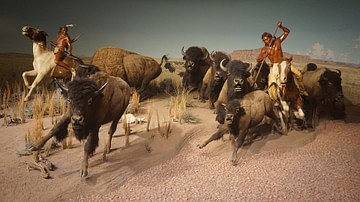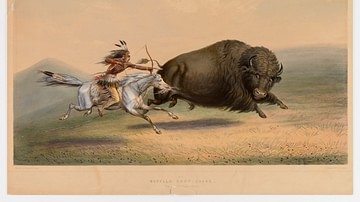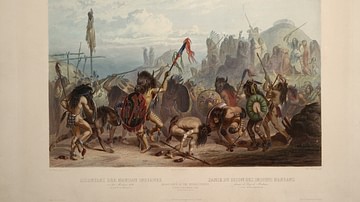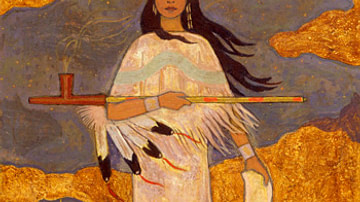Buffalo and Eagle Wing is a legend of the Plains Indians culture of North America, which is part origin myth and part cautionary tale on the importance of keeping one's promises. Although scholars agree on the general provenance of the tale, its attribution to a given nation is unclear.
Although the story is often attributed to the Blackfoot Confederacy, it has also been referenced as a Cherokee legend. The first English translation of the tale is attributed to the writer and teacher Ella E. Clark (l. 1896-1984), who wrote extensively on the oral tradition of the Native Peoples of North America, specifically those of the Pacific Northwest and modern-day Canada, but it is unclear which nation it came from as she first read it in a schoolboy's essay, which omitted that information.

The difficulty in assigning a point of origin to the story is due to the institutionalized assimilation of Native Americans into Euro-American culture as mandated by the curriculum and policies of the American Indian boarding schools (also known as American Indian residential schools), spearheaded by the Carlisle Indian Industrial School (1879-1918). These institutions stripped their Native American students of their culture including, of course, the tradition of storytelling. Regarding Buffalo and Eagle Wing, scholars Margot Edmonds and Ella Clark, write:
This story was written years ago by a pupil at the Haskell Institute, a school for Indian boys and girls. He had heard his grandfather tell it. The boy's exact tribe is unknown, although it was one from the Great Plains. (192)
The Haskell Institute opened as the United States Indian Industrial Training School in 1884, and, although today it enjoys an excellent reputation as the Haskell Indian Nations University, preserving Native culture, it was originally patterned on the Carlisle Indian Industrial School. Buffalo and Eagle Wing, therefore, is of interest to scholars not only for its content but because its missing provenance exemplifies the cultural losses caused by boarding schools across North America.
Boarding Schools & Assimilation
Although Missionary Schools directed toward the conversion and 'civilization' of Native Americans had existed in North America since the Colonial Period, the boarding schools sought to 'kill the Indian to save the man' by removing Native American children from their homes, prohibiting the use of their native languages and traditional observances, including hairstyle and dress, and forced assimilation into Euro-American culture and religion. Students were not allowed to identify, in any way, with their nations, and this extended to mentioning one's people in classwork – such as the essay of the student at Haskell mentioned above.
Civil War veteran and officer Richard Henry Pratt (l. 1840-1924) had fought in the so-called “Indian Wars” between 1868 and 1875, and he was then placed in charge of the Native American prisoners sent to Fort Marion, St. Augustine, Florida. Pratt founded the Carlisle Indian Industrial School on the educational model he had implemented at Fort Marion with these prisoners of war, which included mandatory haircuts, Euro-American dress, and an end goal of complete assimilation. Pratt's now infamous saying, "kill the Indian to save the man", expressed his policies completely in that he believed one only had to encourage assimilation, through military discipline, for Native Americans to reject what he saw as their 'backward culture' and embrace 'civilization' epitomized by Euro-American culture and religion.
Pratt opposed the reservation system and segregation and believed Native Americans could become 'productive members of society' if they converted to Christianity, abandoned their culture, and learned a trade. Boys were instructed in agricultural and industrial work and girls in domestic chores. Students who failed to observe school policy or made mistakes in adhering to various protocols were beaten. Scholar Roxanne Dunbar Ortiz comments:
The stated goal of the project [of the boarding schools] was assimilation. Indigenous children were prohibited from speaking their mother tongues or practicing their religions, while being indoctrinated in Christianity. As in the Spanish missions in California, in the US boarding schools the children were beaten for speaking their own languages, among other infractions that expressed their humanity. Although stripped of the languages and skills of their communities, what they learned in boarding school was useless for the purposes of effective assimilation, creating multiple lost generations of traumatized individuals. (151)
Among the many losses was the tradition of storytelling, which was an integral part of the culture of every Native American nation, and, as noted, Buffalo and Eagle Wing is a prime example of this.

Blackfoot, Cherokee, or Unknown
The story is referenced by many reputable online sites and organizations as a Blackfoot tale. Still, the story is not included in Blackfeet Indian Stories edited by the historian and anthropologist George Bird Grinnell (l. 1849-1938) or Blackfeet Tales of Glacier National Park by James Willard Schultz (l. 1859-1947), both of whom had extensive knowledge of the oral tradition of the Blackfoot Confederacy.
In the work Rise of Environmental Consciousness: Voices in Pursuit of a Sustainable Planet, scholars Beth S. Caniglia, Thomas Jerome Burns, Rachel M. Gurney, and Erik L. Bond attribute Buffalo and Eagle Wing to the Cherokee; but the story does not appear in the comprehensive Myths of the Cherokee by the famous ethnographer James Mooney (l. 1861-1921) who spent years with the Cherokee nation and so would be expected to include a didactic origin myth such as this one among the many others.
The stories of the diverse Native American nations share certain similarities and themes and yet reflect the specific values of that nation. Certain schools of literary criticism – such as deconstructionism – maintain that establishing a point of origin for a tale, and even the author, is irrelevant to an understanding of the text as one should simply engage with the piece itself. Historians and anthropologists, however, place a high value on the point of origin of a given tale for what it says about the culture that produced it.
Because many different nations produced works with similar themes, unless the people of a nation are specifically mentioned in the text, it is often difficult to identify the nation of origin unless it is cited by a work's translator or editor. In the case of Buffalo and Eagle Wing, the scholar who first brought the tale to English readers' attention, Ella Clark, gave the provenance as 'unknown' and so how it has come to be attributed, with apparent certainty, to either the Blackfeet or Cherokee is unclear. Both of these nations hunted buffalo and so why they – or any Plains Indian nation – would have produced a story condemning buffalo hunting is something of a mystery.
This very lack of clarity, however, is what makes the story important to modern scholarship outside of its content. It is probable, if not certain, that the student at Haskell Institute who wrote the story down would have included his nation in the text had he not been prohibited from doing so. The story, then, serves as both a fine example of Native American oral tradition and as a testimony to the cultural losses suffered by Native Americans through the policies of the boarding schools beginning in 1879 and continuing until the Indian Self-Determination and Education Assistance Act of 1975, which gave the nations the right to determine their own children's course of education.

It should also be noted that boarding schools are not a relic of the past and continued after 1975 and into the 21st century, although now, like the Haskell Institute, they support Native American sovereignty and not only preserve but also champion the cultures of North American indigenous peoples. Schools like Haskell are transparent in dealing with their pasts, recognizing the damage done by the earlier educational model.
No Native American nation ever asked Pratt, or anyone else, to take charge of their children's education or their own. The values of the European colonists and later Euro-Americans were at odds with those of the indigenous peoples of North America. The nations did ask, however – repeatedly – that the many treaties they signed with the United States government promising them their lands would be honored; but none of them were.
The Text
Read in this context, Buffalo and Eagle Wing resonates with the theme of broken promises and betrayal (although there is no way of knowing whether the author was referencing US government-Native American relations). The story revolves around a magical buffalo who befriends a young man and his grandmother and, in return for superhuman speed, extracts from the youth the promise that he will not kill buffalo.
The moral of the tale is the importance of keeping one's promises, but at the same time, the story is an origin myth relating how the world came to function as it does, tied directly to the theme of the broken promise. When the story opens, there are no impediments to travel, and the people and buffalo live freely in their own lands; but all of that changes by the time the tale is done.
The following passage is taken from Voices of the Winds: Native American Legends, edited by Margot Edmonds and Ella Clark.
A long time ago there were no stones on the earth. The mountains, hills, and valleys were not rough, and it was easy to walk on the ground swiftly. There were no small trees at that time either. All the bushes and trees were tall and straight and were at equal distances. So, a man could travel through a forest without having to make a path.
At that time, a large buffalo roamed over the land. From the water, he had obtained his spirit power – the power to change anything into some other form. He would have that power as long as he only drank from a certain pool.
In his wanderings, Buffalo often travelled across a high mountain. He liked this mountain so much that one day he asked it, "Would you like to be changed into something else?"
"Yes," replied the mountain. "I would like to be changed into something nobody would want to climb over."
"All right," said Buffalo. "I will change you into something hard that I will call 'stone.' You will be so hard that no one will want to break you and so smooth that no one will want to climb you."
So Buffalo changed the mountain into a large stone. "And I give you the power to change yourself into anything else as long as you do not break yourself."
Only buffaloes lived in this part of the land. No people lived here. On the other side of the mountain lived men who were cruel and killed animals. The buffaloes knew about them and stayed as far away from them as possible. But one day Buffalo thought he would like to see these men. He hoped to make friends with them and persuade them not to kill buffaloes.
So he went over the mountain and travelled along a stream until he came to a lodge. There lived an old woman and her grandson. The little boy liked Buffalo, and Buffalo liked the little boy and his grandmother. He said to them, "I have the power to change you into any form you wish. What would you like most to be?"
"I want always to be with my grandson. I want to be changed into anything that will make it possible for me to be with him, wherever he goes."
"I will take you to the home of the buffaloes," said their guest. "I will ask them to teach the boy to become a swift runner. I will ask the water to change the grandmother into something, so that you two can always be together."
So Buffalo, the grandmother, and the little boy went over the mountain to the land of the buffaloes.
"We will teach you to run swiftly," they told the boy, "if you will promise to keep your people from hunting and killing buffaloes."
"I promise," said the boy.
The buffaloes taught him to run so fast that not one of them could keep up with him. The old grandmother could follow him wherever he went, for she had been changed into Wind.
The boy stayed with the buffaloes until he became a man. Then they let him go back to his people, reminding him of his promise. Because he was such a swift runner, he became a leader of the hunters. They called him Eagle Wing.
One day the chief called Eagle Wing to him and said to him, "My son, I want you to take the hunters to the buffalo country. We have never been able to kill buffaloes because they run so very fast. But you too can run fast. If you will kill some buffaloes and bring home the meat and the skins, I will adopt you as my son. And when I die, you will become chief of the tribe."
Eagle Wing wanted so much to become chief that he pushed from his mind his promise to the buffaloes. He started out with the hunters, but he climbed the mountain so fast that they were soon left far behind. On the other side of the mountain, he saw a herd of buffaloes. They started to run in fright, but Eagle Wing followed them and killed most of them.
Buffalo, the great one who got his power from the water, was away from home at the time of the hunt. On his way back he grew so thirsty that he drank from some water on the other side of the mountain, not from his special pool. When he reached home and saw what the hunter had done, he became very angry. He tried to turn the men into grass, but he could not. Because he had drunk from another pool, he had lost his power to transform.
Buffalo went to the big stone that had once been a mountain.
"What can you do to punish the hunter for what he has done?" he asked Stone.
"I will ask the trees to tangle themselves so that it will be difficult for men to travel through them," answered Stone. "I will break myself into many pieces and scatter myself all over the land. Then the swift runner and his followers cannot run over me without hurting their feet."
"That will punish them," agreed Buffalo.
So Stone broke itself into many pieces and scattered itself all over the land. Whenever the swift runner, Eagle Wing, and his followers tried to run over the mountain, stones cut their feet. Bushes scratched and bruised their bodies.
That is how Eagle Wing was punished for not keeping his promise to Buffalo.





